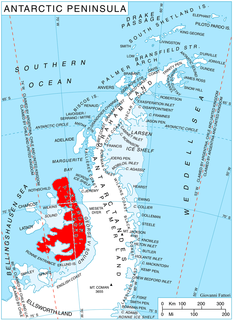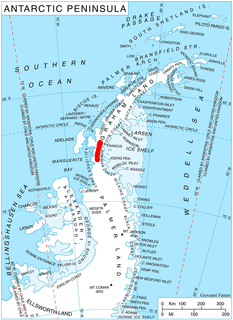
The Sweeney Mountains is a group of mountains of moderate height and about 64 km (40 mi) extent, located 48 km (30 mi) north of the Hauberg Mountains in Palmer Land, Antarctica.

The Usarp Mountains is a major Antarctic mountain range, lying westward of the Rennick Glacier and trending N-S for about 190 kilometres (118 mi). The feature is bounded to the north by Pryor Glacier and the Wilson Hills. Its important constituent parts include Welcome Mountain, Mount Van der Hoeven, Mount Weihaupt, Mount Stuart, Mount Lorius, Smith Bench, Mount Roberts, Pomerantz Tableland, Daniels Range, Emlen Peaks, Helliwell Hills and Morozumi Range.

Cape Longing is a rocky cape on the east coast of Graham Land, Antarctica, forming the south end of a large ice-covered promontory which marks the west side of the south entrance to Prince Gustav Channel. It was discovered by the Swedish Antarctic Expedition under Otto Nordenskiöld in 1902, and so named by him because from the position of his winter hut on Snow Hill Island the cape lay in the direction of his "land of longing" which he was anxious to explore.

Shaw Nunatak is a nunatak rising to 500 m in Nichols Snowfield, northern Alexander Island, Antarctica. It is situated 5.3 km north-northeast of Rachenitsa Nunatak, 4.23 km east-southeast of Tipits Knoll and 7 km southeast of Mount Kliment Ohridski in Sofia University Mountains, 7.5 km southwest of Lizard Nunatak and 8.1 km northwest of Tegra Nunatak. The feature was photographed from the air by Ronne Antarctic Research Expedition in 1947–48, and mapped from these photographs by D. Searle of Falkland Islands Dependencies Survey, 1960. The nunatak was named by United Kingdom Antarctic Place-Names Committee in 1977 after Colin Shaw (1944–78), British Antarctic Survey surveyor who worked in Alexander Island, from 1975 to 1976.
Zonda Glacier is a glacier about 8 miles long, flowing west-southwest between Fohn Bastion and Zonda Towers into George VI Sound. The glacier was included in surveys by Falkland Islands Dependencies Survey (FIDS), 1948, and British Antarctic Survey (BAS), 1971-72, and was photographed from the air by the U.S. Navy, 1966. The name applied by United Kingdom Antarctic Place-Names Committee (UK-APC) in 1977 continues the theme of wind names in the area, as "zonda wind" is the Argentine name for the warm dry wind descending the east slopes of the Andes.
Prospect Glacier is a glacier between Kinnear Mountains and Mayer Hills, flowing north into Forster Ice Piedmont on the west coast of Antarctic Peninsula. It was first roughly surveyed in 1936 by the British Graham Land Expedition (BGLE) under Rymill. In 1954 the United Kingdom Antarctic Place-Names Committee (UK-APC) gave the name Prospect Pass to a col between Eureka Glacier and the glacier here described. During resurvey of the area by the Falkland Islands Dependencies Survey (FIDS) in 1958, the col was found to be an indeterminate feature, while this glacier is well marked and requires a name.
The Brindle Cliffs are a precipitous mass of ice-free rock rising to 610 metres (2,000 ft), standing 6 nautical miles (11 km) east of Cape Jeremy on the west coast of the Antarctic Peninsula. The feature was first seen from the air and photographed on August 16, 1936 by the British Graham Land Expedition under Rymill, and surveyed in 1948 by the Falkland Islands Dependencies Survey who so named it because of its brindle color.

Chamberlin Glacier is a glacier on the east side of Hemimont Plateau which flows northeast into Whirlwind Inlet about 4 nautical miles (7 km) southeast of Matthes Glacier, on the east coast of Graham Land.
Noll Glacier is a glacier, nearly 20 nautical miles (37 km) long, draining northeast from Jones Nunatak in central Wilson Hills. The glacier turns northwest at Wegert Bluff and enters the lower part of Tomilin Glacier before the latter debouches into the sea. Mapped by United States Geological Survey (USGS) from surveys and U.S. Navy air photos, 1960-64. Named by Advisory Committee on Antarctic Names (US-ACAN) for Maj. Edmund P. Noll, United States Marine Corps (USMC), Cargo Officer and LC-130 Aircraft Commander with U.S. Navy Squadron VX-6 during Operation Deep Freeze 1968. Returning from the war in Vietnam in June 1966 he deployed to Antarctica in October that year completing deployments with VX6 for the 1966-67 and 1967-68 season on the ice. He commanded the winter fly-in in 1967 and was co-pilot on the rescue flight from the U,S, base at McMurdo to Haley Bay, the British base across the continent for which he was awarded a single mission AIR Medal. Major Noll completed his military service retiring in 1988 as a Colonel..
Novocin Peak is one of the Bean Peaks, located near the southeast end of this group, in the Hauberg Mountains, Palmer Land. First observed from aircraft by the Ronne Antarctic Research Expedition (RARE), 1947-48. Mapped by United States Geological Survey (USGS) from surveys and U.S. Navy air photos, 1961-67. Named by Advisory Committee on Antarctic Names (US-ACAN) for Norbert W. Novocin, meteorologist at Byrd Station, summer 1965-66.
Petrie Ice Rises is a group of ice rises extending in a north-south line lying merged within the Wilkins Ice Shelf, to the west of Alexander Island, Antarctica. Seen from the air on a British Antarctic Survey (BAS) radio echo sounding flight around Alexander Island, February 11, 1967, and later accurately positioned from U.S. Landsat imagery. Named by United Kingdom Antarctic Place-Names Committee (UK-APC) in 1980 after David L. Petrie, BAS and Scott Polar Research Institute (SPRI) electronic technician, about 1966-70, who was on the flight.

Hale Glacier is a glacier about 6 nautical miles (11 km) long, located just east of Mount Simpson on Thurston Island, Antarctica, and flowing southwest to the Abbot Ice Shelf in Peacock Sound. It was delineated from air photos taken by U.S. Navy Squadron VX-6 in January 1960, and was named by the Advisory Committee on Antarctic Names (US-ACAN) for Lieutenant Bill J. Hale, U.S. Navy, a helicopter pilot aboard USS Burton Island who made exploratory flights to Thurston Island in February 1960.
Meiklejohn Glacier is a glacier, 12 nautical miles (22 km) long and 4 nautical miles (7 km) wide, flowing southwest from the Dyer Plateau of Palmer Land, Antarctica, to George VI Sound, immediately south of Moore Point. In its lower reaches the south side of this glacier merges with Millett Glacier. It was first surveyed in 1936 by the British Graham Land Expedition (BGLE) under John Rymill, and was named by the UK Antarctic Place-Names Committee in 1954 for Ian F. Meiklejohn, a radio operator of the BGLE.
Marr Ice Piedmont is a large ice piedmont which covers the northwestern half of Anvers Island, in the Palmer Archipelago, Antarctica. This feature was presumably first seen by a German expedition under Eduard Dallmann, 1873–74, and was first roughly surveyed by the French Antarctic Expedition, 1903–05, and French Antarctic Expedition, 1908–10, both under Jean-Baptiste Charcot. It was named by the UK Antarctic Place-Names Committee for British marine biologist James W.S. Marr, first commander of the Falkland Islands Dependencies Survey, 1943–45, and leader of the base at nearby Port Lockroy. Marr was also a member of the British Australian New Zealand Antarctic Research Expedition under Mawson, 1929–31, and of Shackleton's expedition of 1921–22.
Massam Glacier is a glacier, 11 nautical miles (20 km) long, flowing north between the Waldron Spurs and Longhorn Spurs to enter the Ross Ice Shelf, Antarctica, just east of the mouth of Shackleton Glacier. It was named by the Southern Party of the New Zealand Geological Survey Antarctic Expedition (1963–64) for D. Massam, a member of that party.

Sloman Glacier is a glacier flowing between Mount Liotard and Mount Ditte to the southeast coast of Adelaide Island. Named by the United Kingdom Antarctic Place-Names Committee (UK-APC) in 1963 for William O. Sloman, British Antarctic Survey Personnel Officer for a number of years beginning in 1956.

Horton Glacier is a glacier at the east side of Mount Barre and Mount Gaudry, flowing southeast from Adelaide Island into Ryder Bay, Antarctica. It was named by the UK Antarctic Place-Names Committee in 1977 for Colin P. Horton, a British Antarctic Survey builder at the nearby Rothera Station, 1976–77.
Relay Hills is a group of low, ice-covered hills, mainly conical in shape, between Mount Edgell and Kinnear Mountains in western Antarctic Peninsula. First roughly surveyed from the ground by British Graham Land Expedition (BGLE), 1936-37. Photographed from the air by Ronne Antarctic Research Expedition (RARE), November 1947. Resurveyed by Falkland Islands Dependencies Survey (FIDS), November 1958. The name, applied by the United Kingdom Antarctic Place-Names Committee (UK-APC), arose because both the BGLE and the FIDS sledging parties had to relay their loads through this area to the head of Prospect Glacier.
Khamsin Pass is a pass at 750 metres (2,460 ft), running north-south between the Relay Hills and the Kinnear Mountains, southward of the Wordie Ice Shelf, Antarctic Peninsula. An important pass used by the British Graham Land Expedition, 1936–37, and subsequent parties, it allows easy access from the Wordie Ice Shelf into Palmer Land. It was named in 1977 by the UK Antarctic Place-Names Committee in association with other wind names in the area, Khamsin being the warm southerly wind in Egypt that comes from the Sahara.










